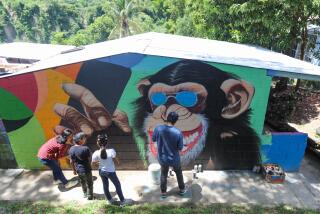Peace Fails to End Struggle Shaped by War
- Share via
EL PAISNAL, El Salvador — As a youth growing up in a farming hamlet, Juan Pastor spray-painted anti-government slogans on walls and joined the crowds at protest marches and strikes as a way to see new places and meet girls.
The epitome of that festive time came in 1979, when he and a comrade occupied the Costa Rican Embassy in San Salvador, one of six missions taken to protest the arrest of Salvadoran leftists in Honduras. Afterward, he was exiled to Panama and sneaked back into the country a year later, after the Marxist revolution had begun.
“It all started out so rosy, until the situation became critical,” he recalled, referring to 12 years of civil war that killed 75,000 people. Pastor’s hometown was bombed out of existence, his brother and stepfather were killed, and he lost both hands and one eye while trying to disarm a land mine.
Now 40, Pastor lives with his wife, Isabel, on about $50 a week that they earn selling loroco, a flowering herb used in typical Salvadoran cuisine. They eat mainly eggs from their own chickens.
Seven years after a peace agreement ended the fighting, Pastor said, “most veterans do not live in good economic conditions. . . . The situation in the country is not encouraging.”
Indeed, most Salvadorans are worse off than they were before the war. GNP per capita was slightly lower in 1997, the most recent year for which information was available, than in 1979, the year the war began. The buying power of the minimum wage was less than one-third as much in 1995 as it was in 1979, according to a recent study by economist Mario Salomon Montesino.
“The rich are richer, and wage earners are poorer,” Montesino said.
The peace agreement curtailed the power of the armed forces, created a civilian police force and opened the political system to diverse views. But the daily lives of people like Pastor have not improved.
“I am sad to see the story a few years afterward,” said Father Rutilio Pedraza, an outspoken priest. “At least before, they had hands to work or to fight. Now they are left without hands and without work. It is gut-wrenching.”
The loss is unmistakable here in El Paisnal. This is the old parish of Father Rogelio Grande, whose 1977 slaying convinced many Salvadoran Roman Catholics that change was vital.
Now, El Paisnal doesn’t have its own priest. And most of the people who fled during the war haven’t come back, Pastor said. Only a few fruit trees mark the site of his hometown, Aseradera.
Pastor recalled his homecoming in 1980. “It was scary,” he said. “The houses were abandoned and burned. There was no one around.” Two members of his family were dead, the rest scattered.
In February 1986, assigned to disarm buried land mines, he was holding one at arm’s length when it exploded.
Pastor learned to use his stubs to swing a machete and hold a cup. He went to school and finished ninth grade.
After the war, like other veterans, he received a small plot of land. Because he was disabled, he received a $115-a-month pension.
But the soil in this region is so infertile, it takes about $92 worth of fertilizer and pesticides to produce a basket of corn that sells for $34, said Porfirio Figueroa, president of the Salvadoran Disabled Ex-Guerrillas Assn.
Pastor planted trees last year on part of the land, but they won’t bear fruit for two to three years. Termites destroyed the shanty his grandmother had left him. He had to pledge his pension on a $2,300 loan to build a two-room house.
“The way things are going,” Pastor said, “people are very disillusioned.”
Pedraza agreed: “The worst of it is that no one can even dream of another revolution. . . . My only consolation is that if, after so much struggle and so much blood, we find ourselves here, where would we be without that struggle and without that blood?”
More to Read
Sign up for Essential California
The most important California stories and recommendations in your inbox every morning.
You may occasionally receive promotional content from the Los Angeles Times.













